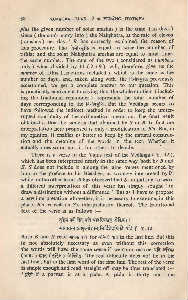Page 706 - Lokmanya Tilak Samagra (khand 2)
P. 706
58 SAMAGRA TILAK- 2 • VEDANG JYOTI~HA
plus the given number of solar amshas ) is the time ( in days )
since ( the sun's entry into ) the Nak~hatra, at the rate · of eleven
( amshas) per day.' B has correctly explained the reason of
this procedure. The f<::ir~ is equal to twice the number of
tithis; and the solar Nak~hatra amshas are equal to nine times
the same number. The sum of the two ( considered as numbers
only ) when divided by 11 ( 2 + 9 ), will, therefore, give us the
number of tithis ( fractions included ), which is the same as the
number of days; and, taken along with the ~~ previously
ascertained, we get a complete answer to our question. This
is practically equivalent to saying that the whole quotient ( includ-
ing the fractional remainder ) represents the total number of
days corresponding to the ~. But the Vedanga seems to
have followed the indirect method in order to keep the uniter-
rupted continuity of the arithmetical operation. The final result
obtained is thus the same as that obtained by S or B. In fact the
interpretation here proposed is only a modification of B's. But, in
my opinion, it enables us better to keep by the natural construc-
tion and the meaning of the words in the text. Whether it
actually does so or not, is for others to decide. ·
There is a verse in the Yajus text of the Vedanga ( Y. 12 ),
which has been interpreted nearly in the same way both by B and
S. S does not include it among the nine verses mentioned by
him in the preface to his Bhashya, as wrongly interpreted by B;
while on the other hand B has observed that S, in putting forward
a different interpretation of this verse has simply sought ' to
draw a distinction without a difference. ' But as I have to propose
a new interpretation altogether, it is necessary to examine, in this
place, B's as well as S's interpretation thereof. The traditional
text of the verse is as follows :-
~ q<f ~ ~ 41;;:~\\1~ ~ I
~sct~~i~ll<t_~1:1<fiT ~ II Y.ll
Both B and S read 01Mcti ~~ for 01~1 ~r~ in the last line. But this
is not absolutely necessary as even without this correction
the words will have the same sense if we can construe ~ ~:
( lWJ:) ~IQ. ( ermr) ~({_. The real difficulty does not lie in the
last line , but in the first word of the first line. The rest of the verse
is simple enough and read straight off may be thus translated :-
' ~ if a parvan is at a pAda. A pada is thirty and . one

